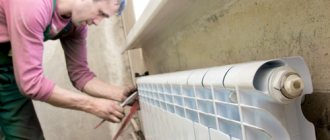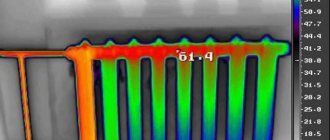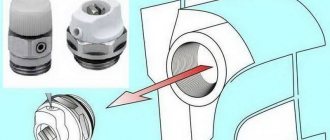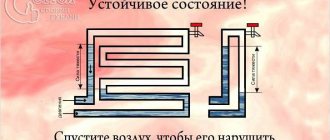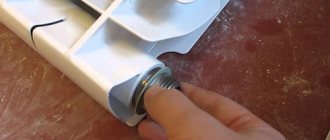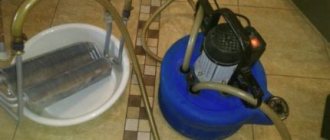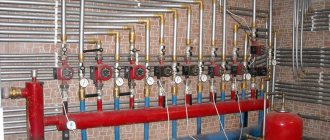How to bleed air from a battery with a Mayevsky tap
The Mayevsky valve is designed to simplify the removal of air locks. In essence, this is a kind of valve on the heating radiator for releasing air. It makes it easy to do it yourself. On radiators it is located in the upper part of the side wall of the outer section. Let's look at how to bleed air from a heating radiator with a tap in an apartment.
To simplify the work, there are special removable handles that fit onto the inner metal part of the valve. If you have one, then expelling air from the heating system will be quite simple. If there is no handle, there may be a notch for a screwdriver on the central part of the faucet.
Place a container with a volume of 0.5-1 liter under the Mayevsky tap. After that, unscrew it and air will begin to come out. After this, air mixed with water will flow into the container with a characteristic hiss under pressure. Wait until clean water flows and close the tap.
Bleeding air from the radiator through the Mayevsky valve
If there is no handle on the Mayevsky tap and there is no way to use a screwdriver, you will need a wrench of the appropriate size. An adjustable or gas one will also work.
- Wrap the surface of the radiator with a rag or rag, and place a water container underneath.
- Slowly unscrew the tap until you feel air movement or hissing. Do not try to rip it off if it is twisted tightly - apply even force.
- Wait until the air comes out and water flows out.
- Drain 1-2 liters of water.
- Turn on the tap and wait 5-10 minutes.
- Turn off the tap again and check to see if there is any air left.
- Repeat the process until all air has left the system.
What is a Mayevsky crane
Since Soviet times, the common people have used the expression “turn off the heating tap.” Then ordinary valves were cut into the cast-iron central heating radiators, through which a large amount of coolant was drained. This was done to release accumulated air in the system, which is why the radiators were downright cold. Later, a special device appeared for bleeding air from heating devices - the Mayevsky tap. In this material we will look at the design of this plumbing fixture, how it functions and is installed.
Purpose and types of Mayevsky cranes
The normal circulation of the coolant in the system can be hampered by air accumulating at its highest points and in the heating radiators. There are only two situations that cause an air lock in the heating system:
- slowly filling or recharging a partially emptied system. At this moment, the upper far corners of the radiators and vertical risers are aired;
- the presence of a large amount of dissolved oxygen in the coolant. It travels throughout the network along with water and gradually accumulates in places convenient for this - the upper blind sections of batteries and pipes;
Note. Excess air in heating pipes can also collect in horizontal sections with U-shaped compensators or in other similar cases when, due to installation conditions, the pipes form loops turned upward.
To avoid airing, automatic air vents or an open type expansion tank are provided at the top of the vertical risers. To remove air from batteries or other tricky places, a special manual tap with a needle valve, invented by Ch. B. Mayevsky back in the 30s of the last century, is used. Currently the product is produced in the following versions:
- traditional, with external thread for installation in various places;
- radiator, with a plastic cap, intended only for use with heating devices;
- complete devices - ball valve with Mayevsky valve.
How the Mayevsky crane works
The design of the crane is extremely simple and therefore reliable. The body of the product is made of brass, as is the working screw for venting air. To ensure the tightness of the device during installation, there is a sealing element in the form of a ring on the outside of it. The figure below shows the design of the Mayevsky crane in radiator design:
1 – brass body; 2 – working screw with ducts; 3 – nylon cap; 4 – sealing ring.
Faucet screws from various manufacturers can have both slots for a screwdriver and a tetrahedral or hexagonal head for a special key. The end of the screw is made in the form of a cone that fits into a hole communicating with the coolant. For the passage of deflated air, there is a hole in the housing, whose diameter is usually 2 mm. Below is a diagram that will allow you to clearly understand the principle of operation of the Mayevsky crane:
Under normal conditions, when the heating system is operating, the air bleed valve is completely sealed. When it is necessary to ventilate the battery, the screw is unscrewed with a screwdriver or wrench a couple of turns. In this case, the accumulated air begins to pass through the calibrated hole and enters the side channel leading out. When performing this operation, you should remember that first the air comes out with a characteristic sound, and then for some time along with the coolant. Therefore, before using the Mayevsky tap, you need to prepare a small container for draining water.
The valve in the traditional version, as well as in combination with a ball valve, functions on the same principle. The difference between them is that a traditional valve fits into places where the circuit requires it, and not just into heating devices. Although the usual Mayevsky tap for cast iron radiators is also suitable, you just need to install it correctly. The air vent, complete with a conventional shut-off valve, is made for convenience, so that these 2 elements do not have to be mounted separately in the right places.
Specifications
The range of products offered on the market is small. The reason for this is simple: the device performs only one function, which does not require the creation of many standard sizes of taps for different pipelines. To this day, only two are sufficient - ½'' and ¾'', in them the tap diameter (by thread) is 15 and 20 mm, respectively. We have listed the types of products according to their purpose above, as well as the fact that screw heads can be offered in different designs - for a screwdriver and various keys.
Note. Sometimes you can use the Mayevsky crane manually, without tools. Some models of air vents for installation in radiators are available with a screw rotating with a plastic handle. But you shouldn’t rush to buy them, especially for a private home where there are small children. A child who accidentally unscrews the valve may get burned by hot water.
The Mayevsky radiator valve is designed for a coolant operating pressure of up to 10 Bar (1 MPa). This is quite enough for installation in the radiators of a three-story private house. If the design pressure in the system is higher, then a traditional tap with a limit of 16 Bar (marked RU16) is installed. All products function normally at coolant temperatures up to 120 ºС.
Due to the simplicity of the design of the Mayevsky valve, its service life is determined only by the quality of the material used - brass. A product made of good material can easily serve for 30 years or more. At the same time, devices made by handicraft may begin to leak quickly or immediately crack during installation. The device also operates normally in conditions where non-freezing liquid is used as a coolant in the system instead of water.
How to bleed air from a radiator if there is no Mayevsky tap
If you don’t have a Mayevsky tap, then you have old-style batteries and a regular plug is installed instead. As a rule, it is covered with a layer of paint, so unscrewing it will not be easy.
To work you will need:
- Rags or rags;
- Gas key;
- Container for draining water;
- Solvent or rust converter;
- Fum tape.
Let's get started:
To begin, place a bucket under the section with the plug. Wrap part of the battery around the plug with a rag - it will prevent high water pressure.
Spray the plug-battery joints generously with solvent or converter. Try unscrewing the plug with a gas wrench. Do not use excessive force to avoid stripping the threads.
If the plug does not budge, use solvent again. When it starts to unscrew, turn it carefully. It is advisable not to take it out completely - otherwise a large stream of water will rush out.
Advice
Install an automatic gas vent instead of the plug. It will periodically bleed the accumulated air and you will no longer wonder how to bleed the air from the heating battery.
The photo shows that in this case the plug has a left-hand thread.
The thread can be left or right. Therefore, try unscrewing the plug in both directions.
As you turn the plug, listen to see if air has escaped. Place your hand to feel the flow. When the air is completely released, wait until 3-5 liters of water flow out of the battery.
Before installing the plug, wrap it in 1-2 layers of fum tape. Do this against the direction of the thread - this will ensure a better seal. Screw the plug as tightly as possible.
Advice
If you decide to paint the end cap or the entire battery, be careful not to get any paint on the joint.
Bleeding air through the expansion tank
In houses with individual heating, expansion tanks are installed. They come in closed and open types.
If the expansion tank is open, the level of water or coolant in it could drop. Add them to the system, preferably through the bottom valve of any radiator. If this does not work, do it directly into the tank.
Start the system and let it run. If the air plug does not come out, you will have to bleed it through the radiator.
If the expansion tank is a closed type, you will have to check the functionality of the tank.
If there is another tap on the battery
Mayevsky cranes appeared quite a long time ago - in 1933 - and immediately began to be used by specialists. Before this, conventional water taps were installed on the batteries. However, the population drained hot water for their needs. With the help of an air vent, unauthorized drainage of the coolant was stopped.
The Mayevsky crane can have a completely different look:
On old cast iron batteries it is often painted over and is almost unrecognizable.
In fact, all Mayevsky cranes are structurally similar:
All manual air vents are used in the same way. The only difference is in the choice of tool for unscrewing the locking screw - it can be a key, a screwdriver, or an adjustable wrench. Often a handle is already attached to the screw - then you can simply turn it with your fingers.
The exception is automatic type air vents. They release air on their own. Externally they differ in the presence of a cap.
Such devices are installed only on modern batteries. They remove air as it accumulates, but are prone to clogging. If the air vent becomes clogged, air will not be removed. Moreover, the valve may leak. Automatic air vents are difficult to clean. Usually they are changed.
There is no place for air in batteries. Air locks are not only cold in winter, but also the cause of metal destruction.
Reasons for the appearance of air in the heating radiator
After you have expelled the air from the radiator, you need to make sure that it does not appear there again. To do this, it is necessary to determine the cause of the formation of an air lock.
Air in an aluminum radiator may appear due to highly acidic water. It reacts with the metal and gas is released. If you have individual heating, replace the water in the system with distilled water.
Some coolants can react with metals. Low-quality, homemade fluids also destroy the radiator. Use only good coolant.
Over time, some coolants release gas or air. At the same time, they lose their properties. Replace the coolant according to the instructions in the specification.
In homes with central heating, air can get into the pipes when they are filled with water at the beginning of the heating season. To prevent this from happening, install an automatic air vent.
In houses with individual heating, air can enter the system when it is filled with water or coolant. It usually comes out through the expansion tank. If it is not there, be sure to install it. If the expansion tank is installed, it may not work properly.
Air in the heating system may appear due to its depressurization, especially if it is not working and water or coolant is present in it. Check all radiators and pipes for leaks, especially at joints.
Fixing a leak in a timely manner can save you from major problems in the future.

